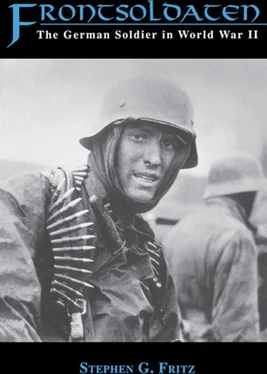Nevertheless, there were clear cases of harassment and sadistic discipline during training. Eisfeld, Albertsen, Landowski, and others spoke of drill sergeants singling out particular recruits for special punishments, finding dirt in completely clean barracks rooms, forcing the men to clean the barracks with toothbrushes, tossing bedding and locker contents onto the floor or out a window, dumping full garbage bins in a freshly cleaned room so that it had to be cleaned again, and denying leave at the last moment for inconsequential reasons. “I could still remember all too well the four hours of punishment handed out to me,” Guy Sajer noted of his personal experience with chickenshit. “I had to put on the ‘punishment pack,’ a knapsack filled with sand, which weighed nearly eighty pounds. I weighed one hundred and thirty. After two hours my helmet was burning hot from the sun, and by the end I needed all my will power to keep my knees from buckling. I had nearly fainted several times. That is how I learned that a good soldier does not cross the barracks yard with his hands in his pockets.” 34
Clearly apparent here is a major characteristic of harassment: the disparity between the transgression and the punishment. Assigned to Christmas Eve stable duty, Siegfried Knappe and his mate were dutifully removing all the soiled straw when a commotion erupted. “[We] stopped our work,” he recalled, “and looked around to see what was happening. The moment we stood up, Weizsacker pounced on us. ‘Ah ha! The intellectuals are loafing,’ he shouted gleefully…. ‘Well, if you have so much free time, I have a perfect solution, especially designed for intellectuals and smartmouths….’ Weizsacker motioned for Vogel to get into the stall with Weinreich and me. ‘Now, let’s see you guys clean this place out with your hands!… That’s right…. Hang up your pitchforks.’” These actions amounted to harassment as an instrument of arbitrary, subjective will, as a means to intimidate men through the exercise of petty authority, to make a man seem, in the words of Günter Dettmann, “like a piece of crap.” 35
If these examples illustrate the existence of mean, cheap chicken-shit, others point to a more sadistic, and dangerous, variety of “instruction.” Werner Karstens recalled a friend and comrade who fell afoul of regulations while they were in training in Stettin. Having met a young woman, his buddy failed to make it back to camp before lights out. In a not atypical example of collective punishment, his entire barracks room unit then suffered the consequences of his misbehavior. His “comrades” exacted revenge, however—what the Landsers called Heiliger Geist (Holy Spirit) or comrades’ justice: the next night they assaulted and viciously beat him with the leg of a stool. Injured so badly that he had to be sent to the hospital, the nineteen-year-old youth eventually suffered amputation of his arm and then died following the onset of infection. A moment’s indiscretion thus caused a young man to be victimized in a cruel act of “self-justice” by his erstwhile comrades. 36
Nor were such occurrences necessarily isolated or limited to the men themselves. Karstens once saw a drill sergeant slam a recruit with all his force into a door. The unfortunate victim, rendered senseless as a result, was quickly mustered out of the army. And finally, in a further example of cruelty, this time psychological, Karstens remembered that when a man in their training unit, sent as a courier to Berlin, died in a traffic accident, the subsequent actions of their captain bordered on pathological insensitivity. The victim’s buddies, while forbidden to attend the funeral, were forced to listen to their captain lament not their comrade’s death but the loss of the vehicle! This heartless example of callous dehumanization left a bitterness in Karstens that the years could not erase. 37
Similarly, Hans Werner Woltersdorf had “no time for the subservient muscle-men who acted authoritarian because they weren’t authoritative…. There would always be those who would rely on a pose, or some injustice, intrigue, or demonstration of power to attempt to compensate for what they lacked.” Woltersdorf particularly recalled “an intelligent lad with character” who had been exposed unmercifully to such harassment. Yet the young man had not only endured, but later, in combat, “had torn up his convalescent leave permit so he could get to the front.” Entrusted by his commander with “a daredevil raid, …he led his raiding party through a mine field that went through the Russian lines, noiselessly took care of the Russian sentries, blew up an ammunition dump, and created a state of hopeless chaos so that he and his men could make their way back through the Russian lines. Going out he went first, coming back he came last; he brought all his men back in one piece, but then, just as he thought he’d made it, he stepped on a mine…. There was very little,” concluded Woltersdorf sadly, “that got me down the way [this] tale did.” 38
Guy Sajer noted that what kept him and his comrades going in the midst of the exhausting training process was not only a desire for success but the pervasive dread of the “punishment battalion.” Sajer remembered with uneasiness “a hut in the courtyard, a roof supported by four stakes, for those who retained some trace of individualism or disobedience.”
This structure was familiarly known as Die Hundehütte (dog house)…. Soldiers being disciplined spent their thirty-six hours of active training like everyone else. However, at the end of this period they were led to the Hundehütte and chained, with their wrists behind their backs, to a heavy horizontal beam. Their eight-hour rest period would be spent in this position…. Soup was brought to them in one of the big tureens for eight, from which they had to lap like dogs…. After two or three sessions in this chalet, the wretched victim… lapsed into a coma, which would put a merciful end to his sufferings…. There was a horrible story about a fellow named Knutke, who had been to the hut six times but who still refused… to follow the section out for training. One day, they took the dying man to the foot of a tree and shot him. “That’s what the hut leads to,” everyone said. “You’ve got to avoid it.” So, despite groans of pain, everyone marched. 39
Here, clearly, was an illustration of murderous discipline, perpetrated by training officers who acted in a ruthless, homicidal manner. Confronted with harassment of this magnitude, a Landser could only hope to endure, defend himself as well as possible, and maintain his self-control.
If for some Landsers training marked a rite of passage to manhood, for others it was simply a bewildering time, even without the harsh exercises and petty harassment. “I have a request of you,” wrote a sixteen-year-old, who had been plunged into overwhelming circumstances by the war, to his parents in late 1944. “I got my pocket knife stolen, perhaps you could get ahold of one somewhere. My suspenders are also shot, they will have to make do, but I don’t know how I’m going to do it. Perhaps Uncle P. still has some. Then could you send me some writing paper, I still had some in my pack, but now it is gone. Perhaps I’ll find it again, but I hardly think so…. P.S.: I lost my watch.” On this level, war was not ironic but concrete, full of pathos and human confusion, concern and consternation. And, as all recruits knew, combat was still to come. Some professed to be eager for action: “I would be ashamed of myself then,” claimed a Landser from the relative comfort and safety of a Kaserne (barracks) in Erfurt, “if I come home and the others are all telling stories of their action.” But for most, actual combat signified a giant step into an unknown world. As Guy Sajer recalled, “I didn’t know what to think. What really happened on a battlefield? I felt torn by curiosity and fear.” 40Soon enough, he and millions of others would know the reality all too well.
Читать дальше












